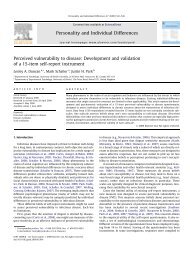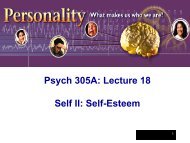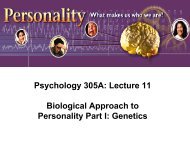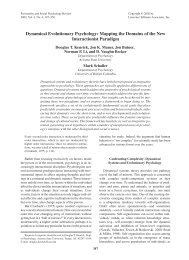Culture and the Self: Implications for Cognition, Emotion, and ... - iacmr
Culture and the Self: Implications for Cognition, Emotion, and ... - iacmr
Culture and the Self: Implications for Cognition, Emotion, and ... - iacmr
You also want an ePaper? Increase the reach of your titles
YUMPU automatically turns print PDFs into web optimized ePapers that Google loves.
230 HAZEL ROSE MARKUS AND SHINOBU KITAYAMA<br />
Table 1<br />
Summary of Key Differences Between an Independent <strong>and</strong> an<br />
Interdependent Construal of <strong>Self</strong><br />
Feature compared Independent Interdependent<br />
Definition<br />
Structure<br />
Important features<br />
Tasks<br />
Role of o<strong>the</strong>rs<br />
Basis of self-esteem 8<br />
Separate from social context<br />
Bounded, unitary, stable<br />
Internal, private (abilities, thoughts,<br />
feelings)<br />
Be unique<br />
Express self<br />
Realize internal attributes<br />
Promote own goals<br />
Be direct; "say what's on your mind"<br />
<strong>Self</strong>-evaluation: o<strong>the</strong>rs important <strong>for</strong><br />
social comparison, reflected<br />
appraisal<br />
Ability to express self, validate<br />
internal attributes<br />
Connected with social context<br />
Flexible, variable<br />
External, public (statuses, roles,<br />
relationships)<br />
Belong, fit-in<br />
Occupy one's proper place<br />
Engage in appropriate action<br />
Promote o<strong>the</strong>rs' goals<br />
Be indirect; "read o<strong>the</strong>r's mind"<br />
<strong>Self</strong>-definition: relationships<br />
with o<strong>the</strong>rs in specific<br />
contexts define <strong>the</strong> self<br />
Ability to adjust, restrain self,<br />
maintain harmony with<br />
social context<br />
* Esteeming <strong>the</strong> self may be primarily a Western phenomenon, <strong>and</strong> <strong>the</strong> concept of self-esteem should<br />
perhaps be replaced by self-satisfaction, or by a term that reflects <strong>the</strong> realization that one is fulfilling <strong>the</strong><br />
culturally m<strong>and</strong>ated task.<br />
iors (Neisser, 1976). Markus <strong>and</strong> Wurf (1987) called this assortment<br />
of self-regulatory schemata <strong>the</strong> self-system. Whenever a<br />
task, an event, or a situation is self-relevant, <strong>the</strong> ensuing processes<br />
<strong>and</strong> consequences are likely to be influenced by <strong>the</strong> nature<br />
of <strong>the</strong> self-system. The self-system has been shown to be<br />
instrumental in <strong>the</strong> regulation of intrapersonal processes such<br />
as self-relevant in<strong>for</strong>mation processing, affect regulation, <strong>and</strong><br />
motivation <strong>and</strong> in <strong>the</strong> regulation of interpersonal processes<br />
such as person perception, social comparison, <strong>and</strong> <strong>the</strong> seeking<br />
<strong>and</strong> shaping of social interaction (see Cantor & Kihlstrom,<br />
1987; Greenwald & Pratkanis, 1984; Markus & Wurf, 1987, <strong>for</strong><br />
reviews). The goal of this article is to fur<strong>the</strong>r specify <strong>the</strong> role of<br />
<strong>the</strong> self-system in behavior by examining how <strong>the</strong>se divergent<br />
cultural self-schemata influence individual experience.<br />
In <strong>the</strong> current analysis, we hypo<strong>the</strong>size that <strong>the</strong> independent<br />
versus interdependent construals of self are among <strong>the</strong> most<br />
general <strong>and</strong> overarching schemata of <strong>the</strong> individual's self-system.<br />
These construals recruit <strong>and</strong> organize <strong>the</strong> more specific<br />
self-regulatory schemata. 3 We are suggesting here, <strong>the</strong>re<strong>for</strong>e,<br />
that <strong>the</strong> exact organization of many self-relevant processes <strong>and</strong><br />
<strong>the</strong>ir outcomes depends crucially on whe<strong>the</strong>r <strong>the</strong>se processes<br />
are rooted in an independent construal of <strong>the</strong> self or whe<strong>the</strong>r<br />
<strong>the</strong>y are based primarily on an interdependent construal of <strong>the</strong><br />
self. For example, in <strong>the</strong> process of lending meaning <strong>and</strong> coherence<br />
to <strong>the</strong> social world, we know that people will show a<br />
heightened sensitivity to self-relevant stimuli. For those with an<br />
independent view of self, this includes in<strong>for</strong>mation relevant to<br />
one's self-defining attributes. For one with an interdependent<br />
view of self, such stimuli would include in<strong>for</strong>mation about significant<br />
o<strong>the</strong>rs with whom <strong>the</strong> person has a relationship or in<strong>for</strong>mation<br />
about <strong>the</strong> self in relation to ano<strong>the</strong>r person.<br />
Affect regulation involves seeking positive states <strong>and</strong> avoiding<br />
negative ones. Positive states are those that enhance or promote<br />
one's view of <strong>the</strong> self, <strong>and</strong> negative states are those that<br />
challenge this view. For a person with an independent view of<br />
self, this involves seeking in<strong>for</strong>mation that confirms or enhances<br />
one's internal, private attributes. The most desirable situations<br />
are those that allow one to verify <strong>and</strong> express those important<br />
internal attributes <strong>and</strong> that convey <strong>the</strong> sense that one is<br />
appropriately autonomous. In contrast, <strong>for</strong> a person with an<br />
interdependent view of self, one might expect <strong>the</strong> most desirable<br />
states to be those that allow one to be responsive to one's<br />
immediate context or that convey <strong>the</strong> sense that one is succeeding<br />
in his or her interdependent relationships or statuses.<br />
A third important function of <strong>the</strong> self-concept suggested by<br />
Markus <strong>and</strong> Wurf (1987) is that of motivating persons, of moving<br />
<strong>the</strong>m to action. The person with an independent view of self<br />
should be motivated to those actions that allow expression of<br />
one's important self-defining, inner attributes (e.g., hardworking,<br />
caring, independent, <strong>and</strong> powerful), whereas <strong>the</strong> person<br />
with an interdependent view of self should be motivated to<br />
3 What <strong>the</strong>se very general cultural self-schemata of independence or<br />
interdependence mean <strong>for</strong> a given individual's articulated view of self<br />
cannot be specified, however. The self-concept derives not only from<br />
<strong>the</strong> cultural self-schema that is <strong>the</strong> focus herein but from <strong>the</strong> complete<br />
configuration of self-schemata, including those that are a product of<br />
gender, race, religion, social class, <strong>and</strong> one's particular social <strong>and</strong> developmental<br />
history. Not all people who are part of an independent culture<br />
will thus characterize <strong>the</strong>mselves as independent, nor will all<br />
those who live as part of an interdependent culture claim to be interdependent.<br />
Within independent <strong>and</strong> interdependent cultures, <strong>the</strong>re is<br />
great diversity in individual self-definition, <strong>and</strong> <strong>the</strong>re can also be<br />
strong similarities across cultures. For example, many artists, whe<strong>the</strong>r<br />
Japanese or American, may describe <strong>the</strong>mselves as noncon<strong>for</strong>mist,<br />
innovative, <strong>and</strong> breaking with tradition. And many aspects of <strong>the</strong>ir<br />
behavior are indeed very similar. Yet, noncon<strong>for</strong>mity Japanese-style<br />
<strong>and</strong> noncon<strong>for</strong>mity American-style, although similar in some respects,<br />
will not, because of <strong>the</strong> differences in <strong>the</strong>ir supporting cultural contexts,<br />
be identical. For Japanese, noncon<strong>for</strong>mity is a privilege af<strong>for</strong>ded<br />
only to selected, talented individuals whose deviance from <strong>the</strong> norm of<br />
interdependence is implicitly sanctioned by <strong>the</strong> rest of society. For<br />
Americans, noncon<strong>for</strong>mity is regarded as every individual's birthright.







